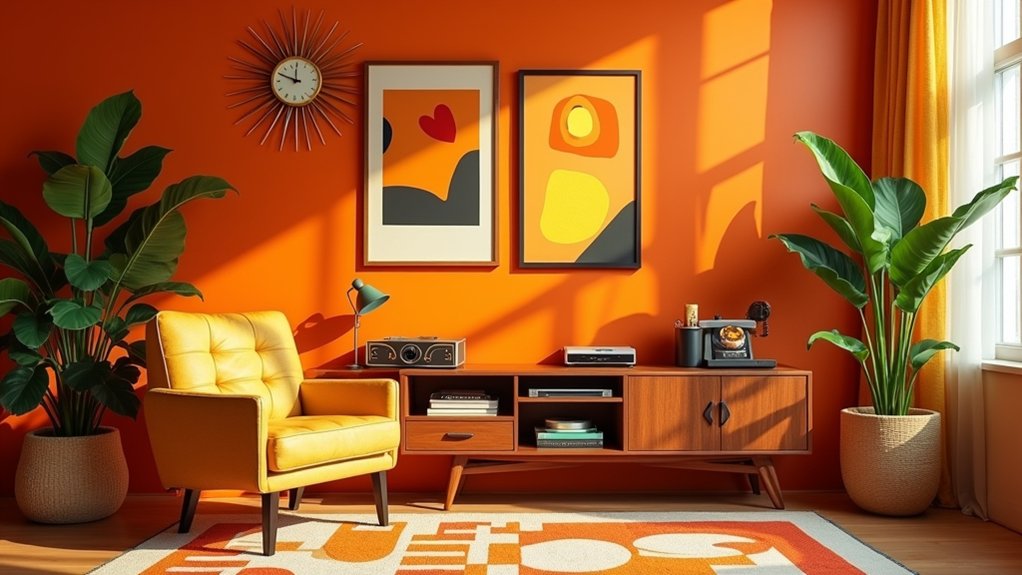
15 Orange Living Room Aesthetic Ideas That Feel Fun and Retro
Orange brings a lively retro flair to living rooms through bold accent walls, geometric wallpaper, and dynamic pairings with navy, mustard, or deep blue. Incorporate chunky-knit throws, velvet or leather sofas, and copper accents for tactile richness and warmth. Mix patterned rugs with statement artwork for anchored visual interest. Small spaces benefit from compact orange decor, while vintage finds and DIY touches personalize the scheme. Discover additional creative pairings and layout ideas that keep the space feeling both fresh and nostalgic.
Key Takeaways
- Pair burnt orange with deep blue or mustard for a playful, retro-inspired color scheme that channels mid-century modern energy.
- Use a bold orange accent wall to create a dynamic focal point while keeping other walls neutral for balance.
- Layer chunky-knit throws, patterned cushions, and geometric rugs in warm tones to add texture and cozy vintage charm.
- Incorporate orange statement sofas or vintage mid-century furniture, and enhance with metallic accents like copper or brass for retro sophistication.
- Personalize with DIY orange decor, like reupholstered chairs or painted vases, to infuse unique character and nostalgia into the space.
Embrace Bold Orange Accent Walls
When strategically implemented, bold orange accent walls establish a dynamic focal point that instantly enlivens the living room and enhances its visual energy. A deep burnt orange wall functions as an accent color, infusing the space with retro character and warmth.
Expert designers recommend pairing this saturated hue with mid-century modern furnishings, allowing the orange wall to contrast effectively against neutral backdrops such as gray or beige. This juxtaposition maintains balance and prevents visual overwhelm.
Pair bold orange walls with mid-century modern pieces and neutral tones to create striking contrast without sacrificing balance or serenity.
Thoughtful accessorizing is key—incorporating textiles or decor in navy blue or deep teal enhances cohesion and sophistication. For ideal impact, limit the use of orange to a single wall, ensuring the accent color remains purposeful rather than overpowering.
This approach yields a vibrant yet harmonious living environment.
Layer Retro Geometric Wallpaper
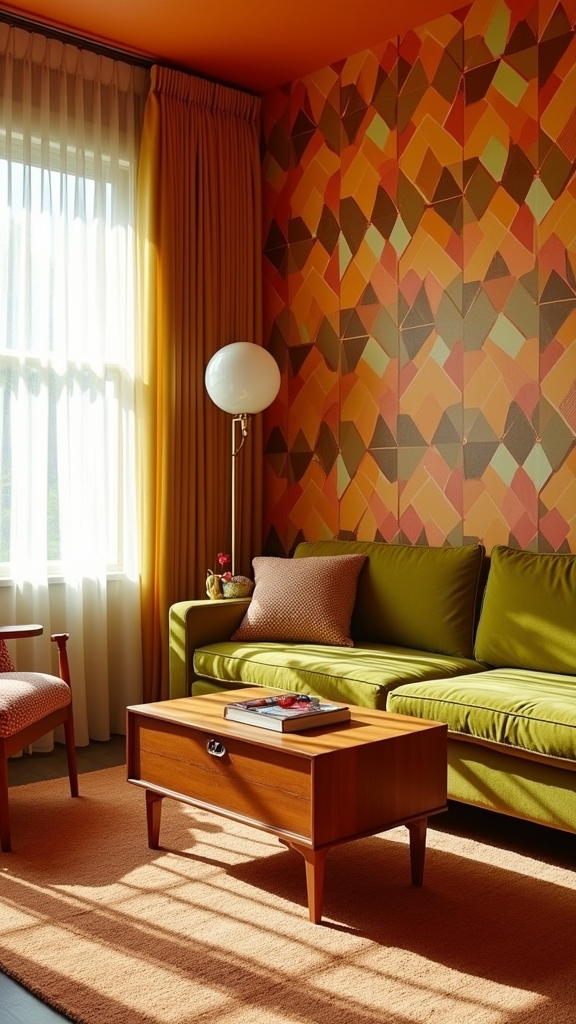
Retro geometric wallpaper introduces an energetic interplay of pattern and color, elevating the orange living room aesthetic with visual dynamism.
Expertly selected bold patterns—particularly those featuring coral, ochre, or even contrasting deep hues—create a visually striking backdrop that enhances the fun aesthetic central to retro-inspired interiors.
Strategic placement above a dado rail or behind shelving units helps define focal areas, preventing visual overwhelm while injecting personality.
For added dimensionality, wallpapers incorporating varying textures invite tactile interest and depth.
Integrating retro geometric wallpaper with vintage furniture or mid-century accessories guarantees a cohesive narrative, unifying disparate elements into a nostalgic yet contemporary scheme.
This approach enables homeowners to experiment confidently, layering patterns and tones that both complement and accentuate the existing orange palette for a distinctively playful ambiance.
Pair Burnt Orange With Deep Blue
Building on the dynamic energy of geometric wallpaper, incorporating burnt orange with deep blue infuses the living room with a sophisticated yet playful palette.
The bold juxtaposition of burnt orange and deep blue creates visual vibrancy, channeling a distinct retro aesthetic reminiscent of mid-century modern interiors. Deep blue serves as a stabilizing backdrop, allowing burnt orange accents—such as cushions, poufs, or decorative ceramics—to stand out without dominating the space.
For maximum cohesion, designers recommend integrating deep blue through substantial elements like wall paint or upholstered sofas, while reserving burnt orange for smaller, interchangeable accessories.
Layered lighting techniques in the living room can enhance the ambiance by using pendant lights or ceiling fixtures to complement the retro color scheme.
Patterned rugs or graphic art pieces that echo both hues further enhance the interplay, reinforcing a lively yet balanced atmosphere ideal for contemporary and vintage-inspired living environments.
Add Chunky-Knit Throws and Cushions
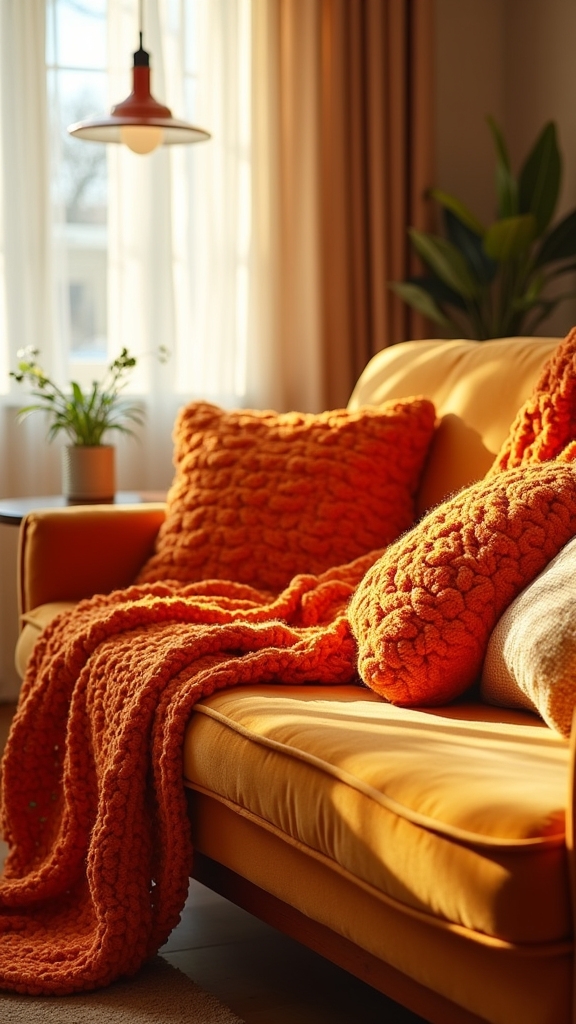
Strategically layering chunky-knit throws and cushions introduces tactile richness while amplifying the cozy ambiance of an orange-themed living room.
Integrating earthy warm tones—such as terracotta, sienna, and ochre—alongside burnt orange creates a harmonious palette that grounds the retro aesthetic.
For greater depth, designers recommend mixing cushion shapes and sizes, ensuring both visual interest and inviting comfort.
Layer for Cozy Texture
A well-curated selection of chunky-knit throws and cushions instantly enhances the tactile experience in an orange living room, imparting both warmth and visual depth.
Layering multiple throws and cushions across sofas or accent chairs amplifies the cozy atmosphere, inviting relaxation while introducing intricate textures. Chunky-knit throws serve as statement pieces, their substantial weave creating a visually dynamic contrast against sleek upholstery or mid-century frames.
For peak effect, combine cushions in varying sizes—mixing burnt orange with complementary hues and diverse patterns such as geometric prints or florals. This strategic approach not only maximizes comfort but also reinforces the playful, retro undertones characteristic of the aesthetic.
Thoughtful placement of these layered textiles guarantees the seating environment feels approachable, cohesive, and visually stimulating without overwhelming the space.
Mix Earthy Warm Tones
When curating an orange living room, introducing chunky-knit throws in earthy warm tones—such as burnt orange, mustard, and rust—establishes both tactile interest and a visually cohesive palette.
These textiles, when draped over seating or layered atop sofas, infuse the retro aesthetic with a sense of warmth and nostalgia reminiscent of mid-century modern interiors.
To enhance visual depth, cushions in complementary shades like deep blue or soft gray can be strategically placed, providing contrast while maintaining harmony within the color scheme.
Mixing patterns and textures through chunky-knit accessories not only reinforces the inviting atmosphere but also draws attention to focal seating areas.
This approach guarantees the living room feels both dynamic and cohesive, where earthy warm tones underscore the fun and timeless retro aesthetic.
Mix Orange With Mustard and Navy
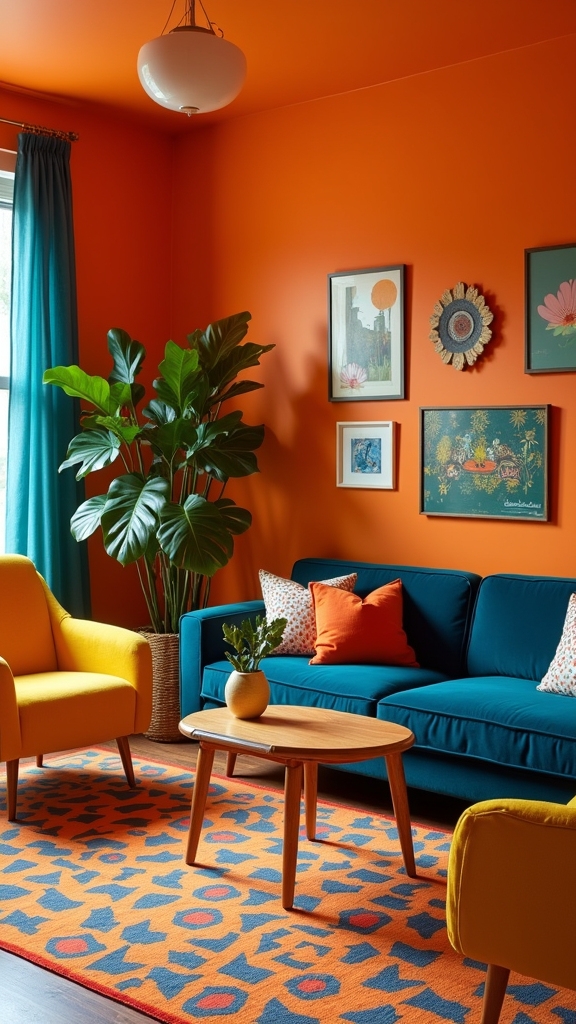
By integrating orange with mustard and navy, designers achieve a dynamic yet balanced palette that channels retro sophistication in the living room. In contemporary living room design, these complementary colors evoke the warmth and vibrancy of mid-century interiors. Mustard and burnt orange textiles, such as curtains or upholstery, infuse the space with energy and a playful retro character. Navy, meanwhile, functions as a stabilizing anchor—ideal for substantial furniture pieces or accent walls—providing visual depth and contrast against the brighter hues. To reinforce the 1960s aesthetic, geometric patterns in this color trio can be incorporated through area rugs, throw pillows, or artwork. This strategic application of color and pattern guarantees a cohesive, visually compelling environment that remains both inviting and timeless. Additionally, luxurious rugs with subtle textures enhance depth in the living room, offering a sophisticated foundation that complements the retro color scheme.
Highlight Mid-Century Modern Furniture
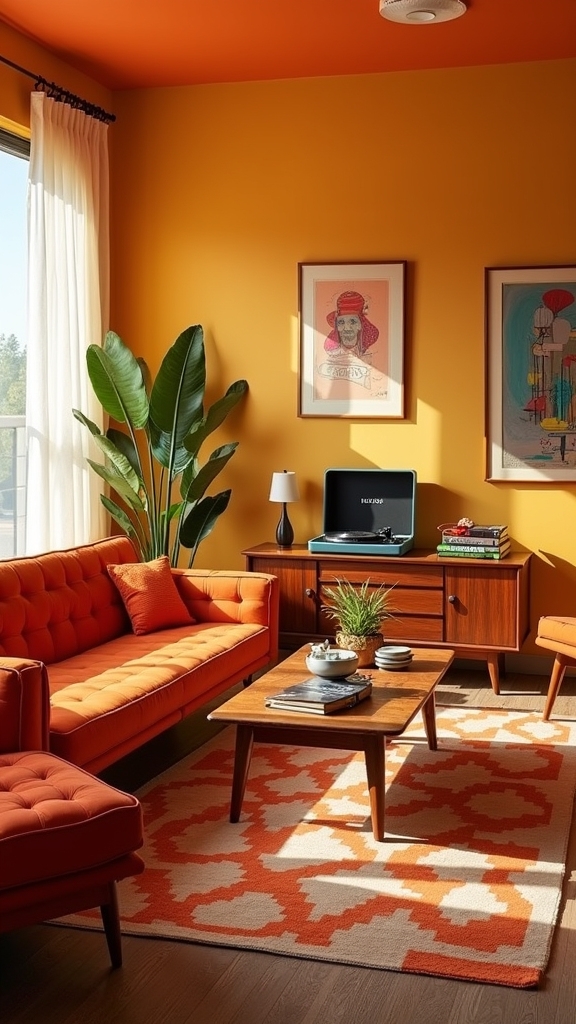
Anchoring an orange living room with mid-century modern furniture enhances both visual interest and functional appeal. Mid-century modern furniture, known for its clean lines and organic curves, pairs seamlessly with the bold vibrancy of orange, establishing an immediate retro aesthetic.
Iconic pieces—such as Eames molded plywood chairs or Saarinen tulip tables—offer sculptural silhouettes and practical utility, while their classic tapered legs introduce a sense of openness, counterbalancing the intensity of orange hues.
Integrating rich walnut or teak finishes found in authentic mid-century designs can ground the palette, providing warmth and sophisticated contrast.
To further reinforce the mid-century modern vibe, geometric-patterned textiles or ceramic accessories may be incorporated, subtly tying together the room’s architectural elements and color story for a cohesive, inviting environment.
Incorporate Playful Patterned Rugs
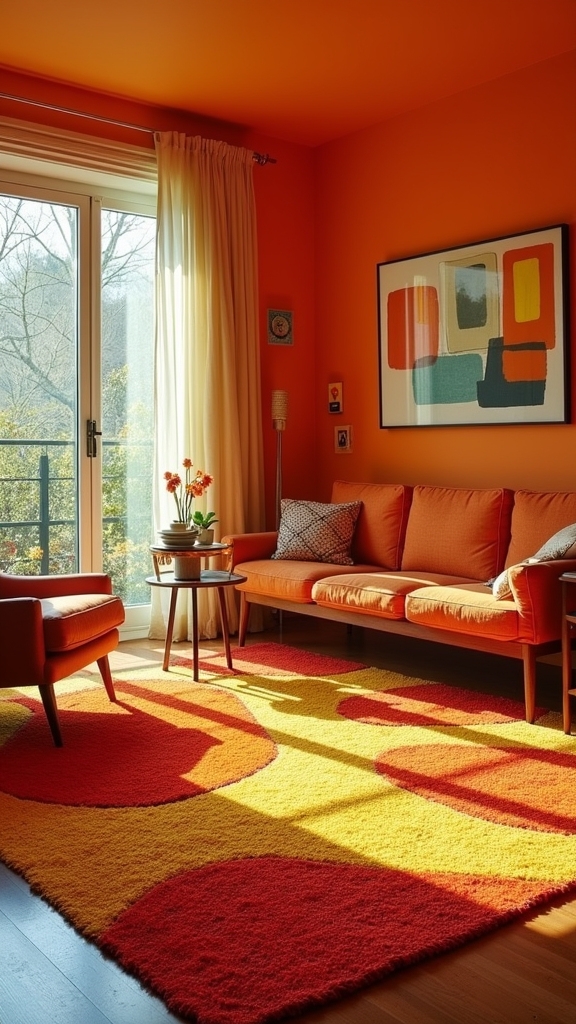
Although orange walls inherently command attention, introducing playful patterned rugs can further enhance the room’s visual dynamics by anchoring the space with texture and color. Selecting geometric or retro-inspired designs aligns with the mid-century modern aesthetic, complementing the boldness of orange while maintaining a cohesive look. Contrasting hues—such as navy blue or mustard yellow—can intensify the visual impact, making the rug a vibrant focal point. For added depth, layering a playful patterned rug over a neutral jute or sisal base delivers both dimension and warmth. Regularly updating the rug revives the retro ambiance effortlessly. Incorporating earthy color schemes like camel and terracotta can ground the space, adding a cozy backdrop that complements the bold orange and patterned elements.
Style With Copper Mirrors and Metallics
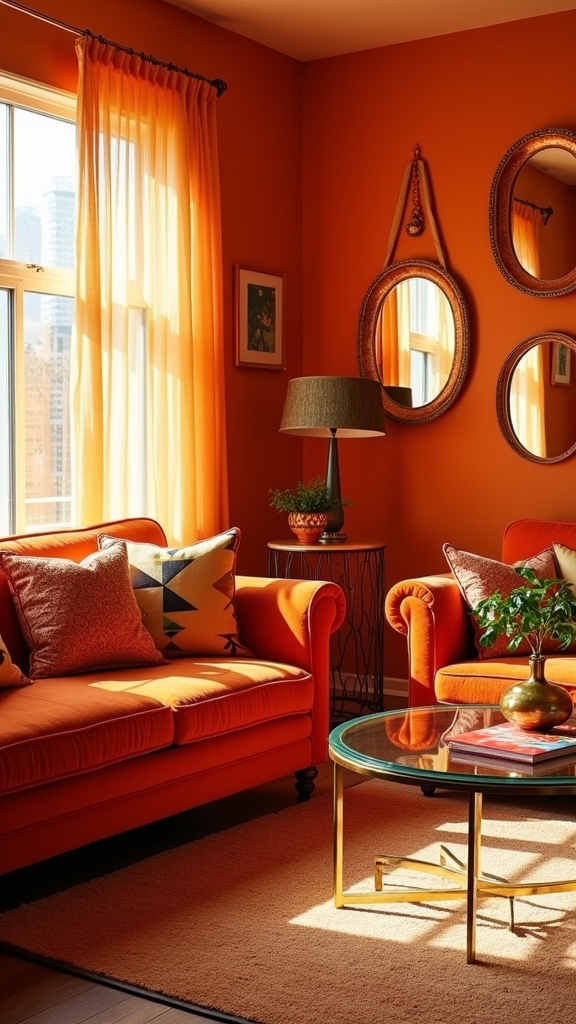
Copper accents introduce a sophisticated interplay of light and warmth within an orange living room, seamlessly elevating the overall aesthetic.
Copper mirrors serve as dynamic focal points, capturing and reflecting ambient light to amplify the inviting undertones of orange walls or decor. Their rounded forms evoke a retro sensibility, especially when paired with mid-century modern furnishings.
Integrating metallic elements—such as brass or gold accessories—alongside copper mirrors creates a curated contrast while reinforcing the space’s vibrancy.
For ideal effect, copper mirrors should be positioned to reflect both natural and artificial light, visually expanding the room and unifying disparate design components.
Mixing metallic finishes with warm neutrals tempers the boldness of orange, resulting in a balanced, cohesive environment that feels both playful and refined.
Use Orange Leather or Velvet Sofas
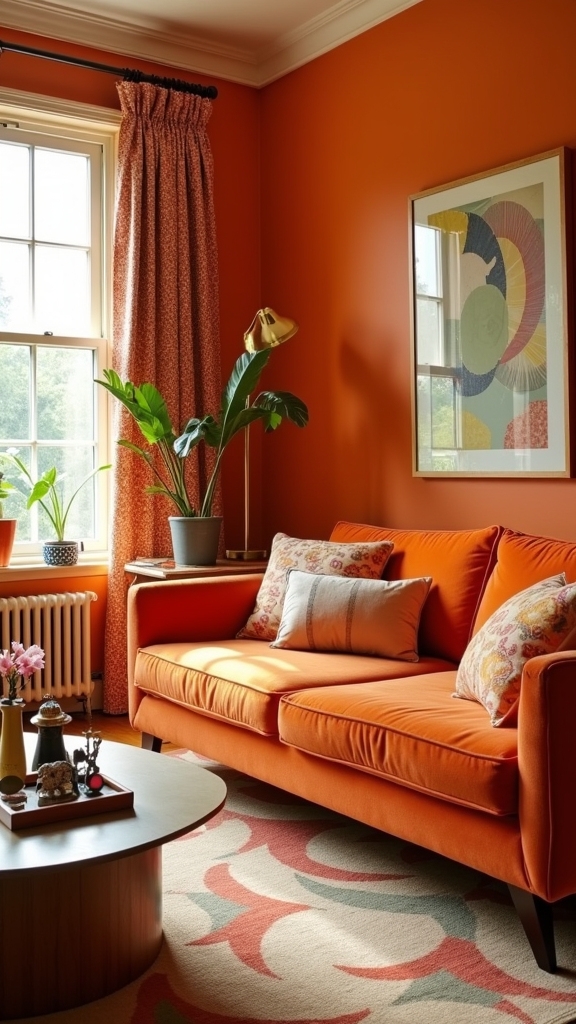
Orange leather or velvet sofas function as statement pieces, anchoring the living room with bold color and retro-modern appeal.
Selecting between plush velvet and sleek leather introduces contrasting textures, enriching the sensory and visual depth of the space.
To maximize impact, experts recommend balancing the sofa’s vibrancy with neutral walls and layering in accent textiles for cohesion.
Statement Sofas for Impact
A single bold piece, such as a leather or velvet sofa in a vivid orange hue, can dramatically transform a living room’s aesthetic by injecting both color and texture. Statement sofas for impact leverage orange as a dominant color, setting a retro tone while anchoring the space visually. The choice between leather and velvet finishes determines the overall atmosphere: leather offers a sleek, modern sheen, while velvet brings a plush, inviting warmth. To maximize the effect, designers recommend pairing orange sofas with mid-century modern accents and balancing their vibrancy with neutral or subdued furnishings. Strategic color pairing with deep blues or mustard yellows in accessories can enhance cohesion.
| Sofa Material | Visual Impact | Suggested Pairings |
|---|---|---|
| Leather | Sleek, polished | Minimalist tables, chrome lighting |
| Velvet | Plush, warm | Patterned rugs, wood accents |
| Both | Focal point, retro | Muted walls, geometric cushions |
Mixing Textures for Depth
While a statement orange sofa establishes the room’s visual anchor, the interplay of complementary textures enhances its overall impact.
Selecting an orange leather or velvet sofa introduces both retro flair and tactile richness—leather’s sleek durability contrasts beautifully with velvet’s plush, light-reflective surface.
For effective mixing textures, layer the sofa with chunky-knit throws and patterned pillows in saturated, contrasting hues. This approach creates a dynamic yet cohesive look, preventing the bold centerpiece from overwhelming the space.
Incorporate additional textured elements, such as a rust-toned area rug or brass decor accents, to reinforce the retro aesthetic and add depth.
Geometric patterns in accessories further highlight mid-century modern influences, ensuring the living room feels both curated and inviting while amplifying visual interest.
Balance Orange With Cool Gray Tones
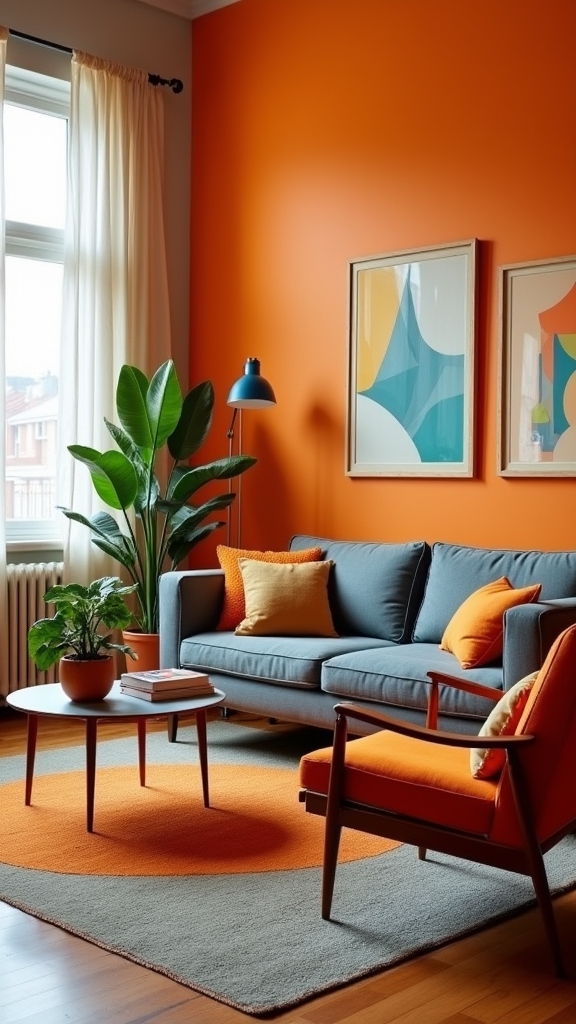
Striking a harmonious interplay between vibrant orange and cool gray tones enhances a living room’s aesthetic, merging energy with sophistication.
Utilizing gray walls as a foundational element offers a neutral backdrop, allowing the warmth of orange accents to command visual attention without overwhelming the space. This strategic contrast not only injects vibrancy but also maintains a sense of balance and cohesion, especially within modern or mid-century modern interiors.
Expert application of various gray shades deepens spatial dimension while enabling burnt orange décor elements to stand out. Incorporating statement lighting fixtures can further enhance the ambiance and style of the space, ensuring that the lighting complements the room’s overall aesthetic and scale.
For a visually engaging and practical approach, consider the following:
- Pair orange cushions or rugs with light gray sofas
- Utilize charcoal gray walls to anchor bright orange accessories
- Integrate geometric-patterned textiles for retro flair
- Select metallic gray finishes for added refinement
- Layer multiple gray tones for nuanced depth
Display Vibrant Art Above Sofas
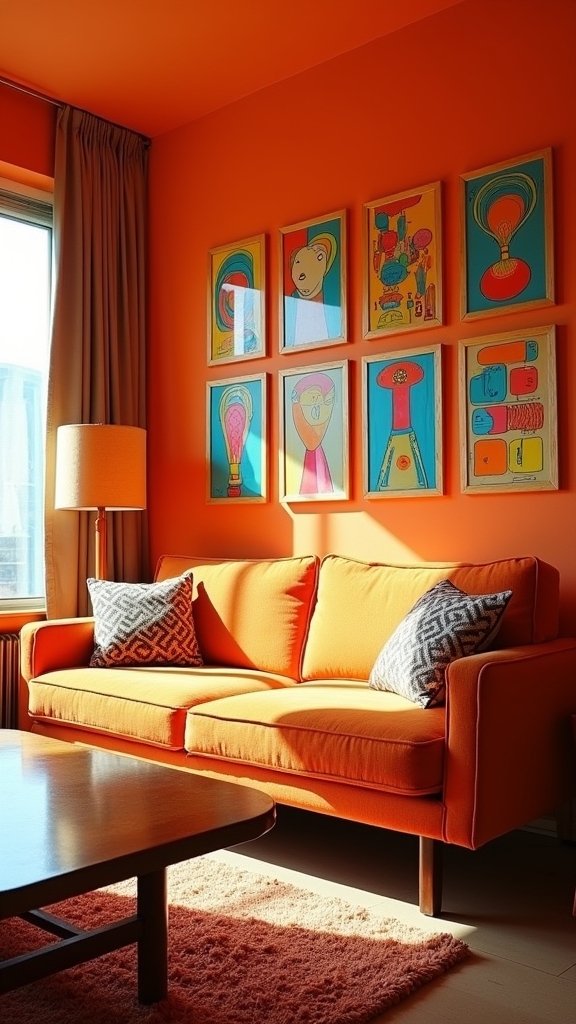
Many designers recommend anchoring an orange living room with bold, vibrant artwork displayed above the sofa to instantly establish a strong visual focal point. Selecting wall art that incorporates complementary hues—such as deep blue or mustard yellow—enhances cohesion and infuses the space with dynamic energy. Large-scale pieces effectively bridge empty wall expanses, ensuring the area feels intentional and unified. For added dimension, a curated gallery wall featuring framed prints, photographs, and colorful canvases can introduce visual depth and layered interest. Retro-inspired selections, including pop art or abstract motifs, reinforce the nostalgic undertones central to a retro aesthetic. Incorporating 3D wall panels can add contemporary dimension to the space, enhancing the overall visual and tactile experience.
Create a Cozy Reading Nook
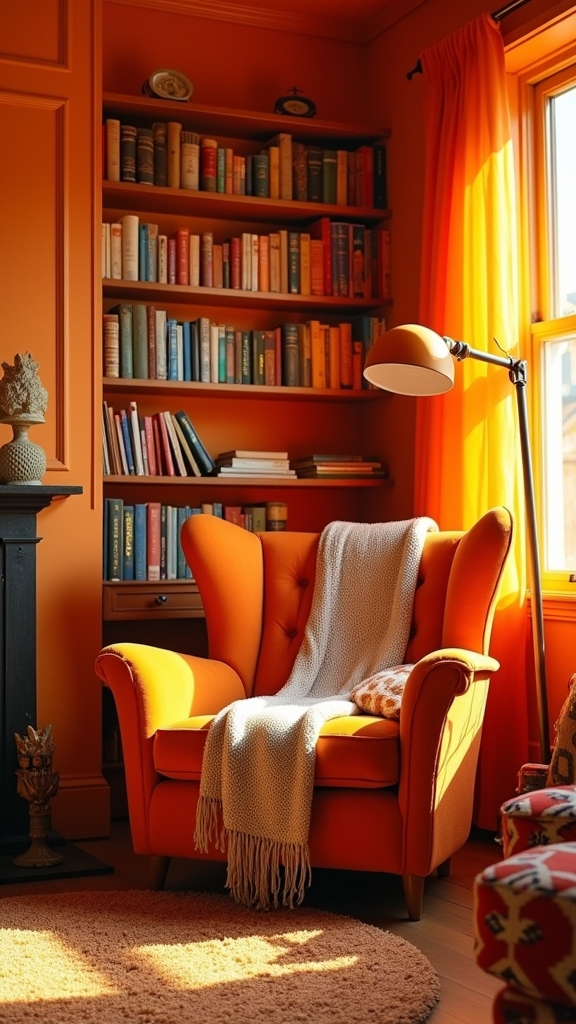
To establish a cozy reading nook within an orange living room, designers recommend selecting a well-lit corner—preferably near a window—to maximize natural illumination and comfort.
This strategic placement not only enhances the ambiance but also supports practical reading needs. Burnt orange serves as the primary hue, evoking warmth and retro flair, while accent colors introduced through textiles and accessories add depth.
For a sophisticated, layered effect, experts suggest the following elements:
- Burnt orange cushions and chunky-knit throws for tactile comfort and visual warmth
- A plush, burnt orange rug to anchor the cozy reading nook and unify the design
- Patterned pillows in complementary accent colors to introduce texture and visual interest
- A round copper mirror above the chair to reflect light and create a focal point
- An inviting armchair or chaise lounge positioned for ideal daylight exposure
Integrate Orange in Open-Concept Spaces

Building on the warmth and comfort established in a dedicated reading nook, orange can be leveraged as a cohesive element throughout open-concept living spaces. Strategic use of burnt orange accents—such as pillows, throws, and rugs—guarantees a cohesive design linking the living and dining zones. An orange accent wall visually anchors the space, providing a focal point that unifies the overall aesthetic. Smaller decorative elements, including orange vases or artwork, can bridge connecting areas, assuring visual continuity. Defining separate zones with burnt orange rugs adds both vibrancy and clarity to multifunctional layouts. The following table illustrates practical applications:
| Area | Orange Accent Inspiration |
|---|---|
| Living Zone | Burnt orange throw pillows |
| Dining Zone | Orange ceramic vases |
| Connecting Space | Abstract orange artwork |
This approach guarantees harmony and flow across open layouts.
Energize Small Spaces With Orange Accents
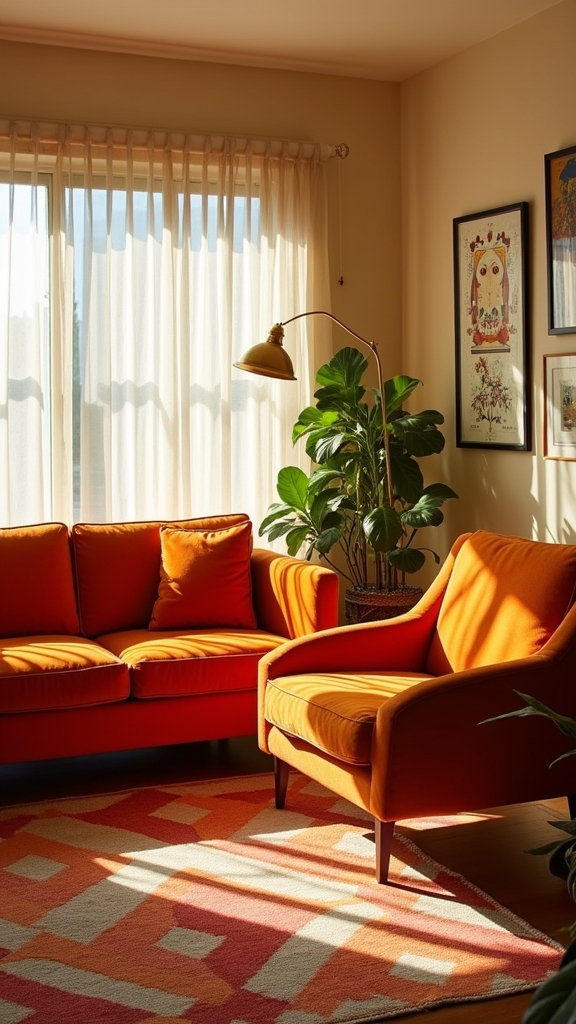
Strategically introducing burnt orange accents instantly enhances the energy of compact living rooms, delivering both warmth and visual interest without crowding the space.
In a small living room, orange decor elements can be expertly layered to create depth and a lively atmosphere while maintaining balance. For maximum effect, consider the following design strategies:
- Integrate burnt orange cushions and throws to infuse coziness and vibrant color without overwhelming the setting.
- Select a burnt orange area rug to anchor the space, adding both texture and visual connectivity.
- Employ an accent wall in a bold orange tone to establish a dynamic focal point and visually expand the room.
- Pair orange decor elements with neutral shades such as gray or beige to moderate intensity.
- Incorporate compact accessories—vases or trays—for subtle, flexible pops of color.
Combine Vintage Finds With DIY Orange Decor
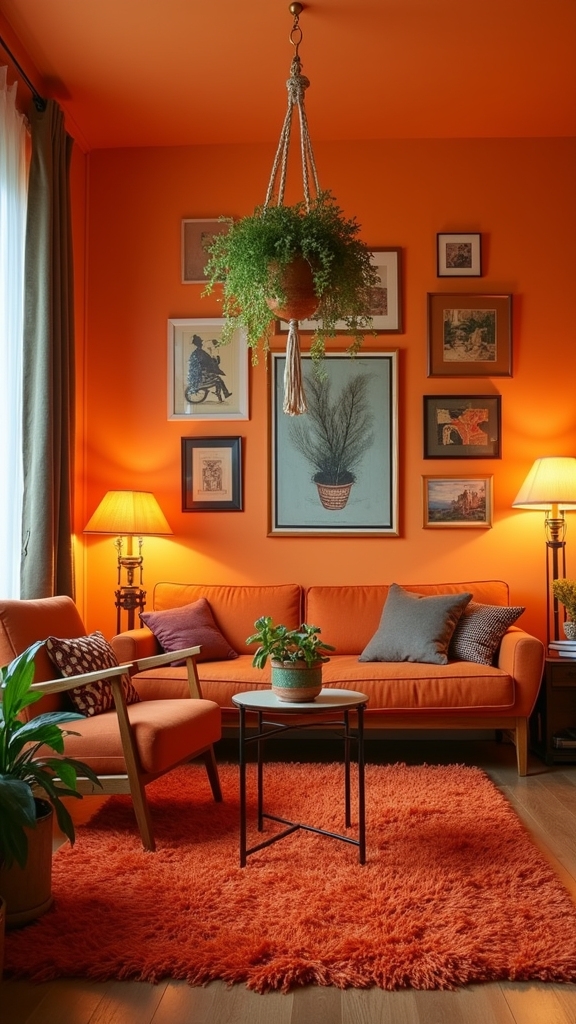
Eclecticism defines a living room where vintage finds intersect with DIY orange decor, yielding a space rich in character and visual dynamism.
Mid-century modern furniture in burnt orange tones grounds the room in retro nostalgia, while geometric wallpaper amplifies the era’s playful energy.
For tactile depth, layer chunky-knit throws and cushions in varying orange hues, selecting patterns that echo vintage motifs for cohesion.
Sourcing unique vintage finds from flea markets or platforms like Etsy guarantees authenticity and visual intrigue.
Complement these with DIY decor—reupholster chairs in vibrant orange fabrics or transform thrifted vases with custom orange finishes.
Incorporating artisanal finds like handcrafted sculptures or bespoke vases adds charm and enhances the unique appeal of the living room.
This curated approach harmonizes retro elements with personalized creativity, resulting in a living room that balances historic reverence with contemporary, hands-on flair.
Frequently Asked Questions
Is Orange a Good Color for a Living Room?
According to color psychology, orange fosters warmth and sociability, aligning well with current living room trends. Visually, it enhances spatial energy; experts recommend pairing orange with neutrals or contrasting hues for balanced, inviting, and contemporary interiors.
How to Design a Vintage Living Room?
Designing a vintage living room involves selecting vintage furniture with mid-century silhouettes, integrating retro accessories like brass lamps or patterned textiles, and layering bold color palettes. Geometric wallpaper and textured throws enhance authenticity, creating a visually striking, cohesive retro space.
How Do You Style an Orange Room?
Styling an orange room involves layering orange decor with playful accents such as geometric textiles and patterned rugs. Expertly contrast orange walls with deep blue elements, integrate mid-century furniture, and finish with metallic accessories for visual cohesion and retro flair.
What Colors Go With Burnt Orange in a Bedroom?
When selecting complementary colors for burnt orange in a bedroom, experts recommend pairing it with deep navy, warm neutrals, and muted earth tones. Accenting with metallic finishes or soft pastels enhances visual interest while maintaining a cohesive, inviting atmosphere.
Conclusion
Incorporating orange into living room design offers a dynamic, visually stimulating environment that expertly balances retro charm with modern flair. Strategic use of accent walls, textured textiles, and complementary color palettes like deep blue and mustard creates a cohesive yet playful aesthetic. Whether layering geometric wallpaper or introducing vibrant accessories, these practical ideas allow homeowners to experiment confidently. Thoughtful integration of orange elements guarantees a space that feels inviting, energetic, and distinctly personalized for contemporary living.
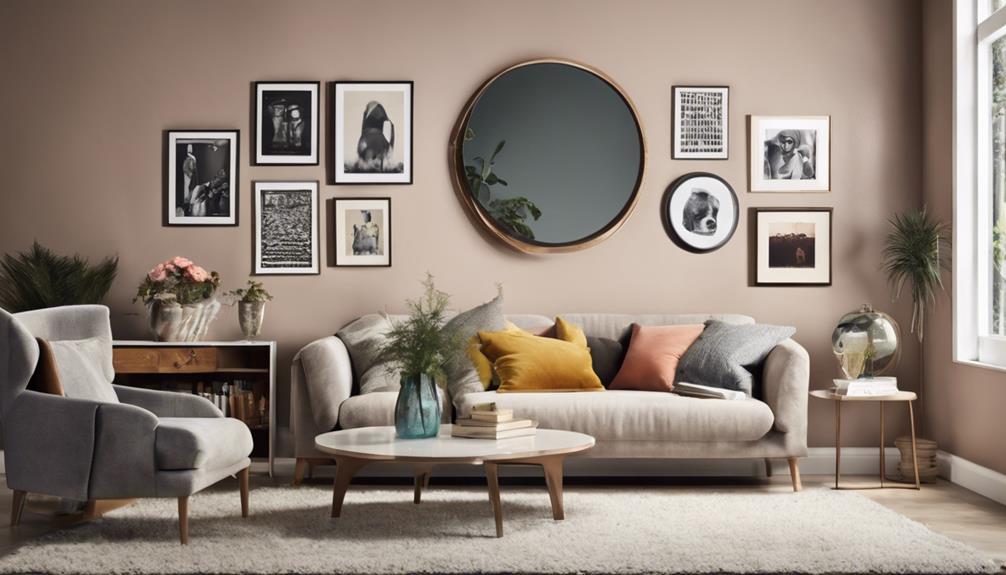
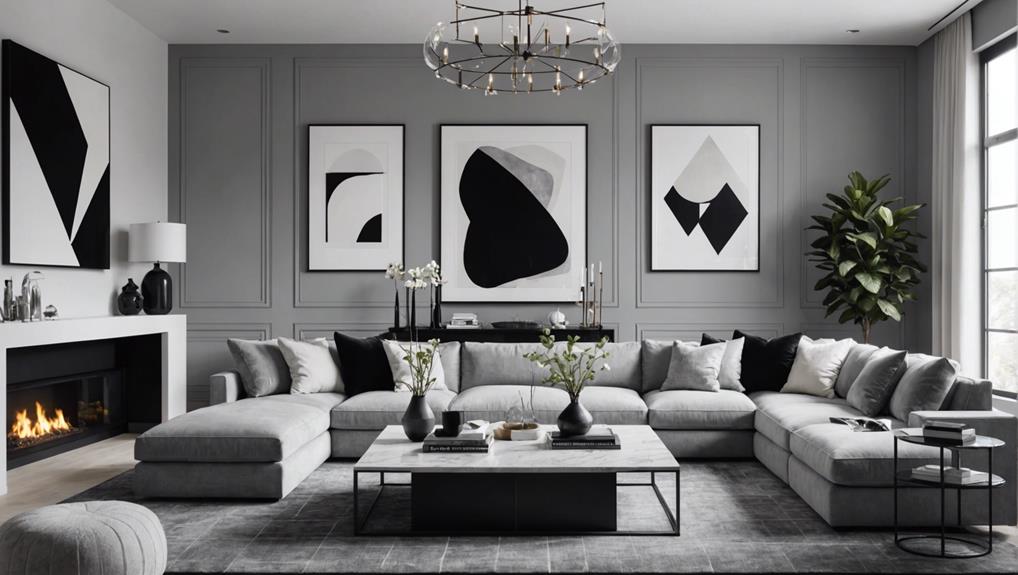
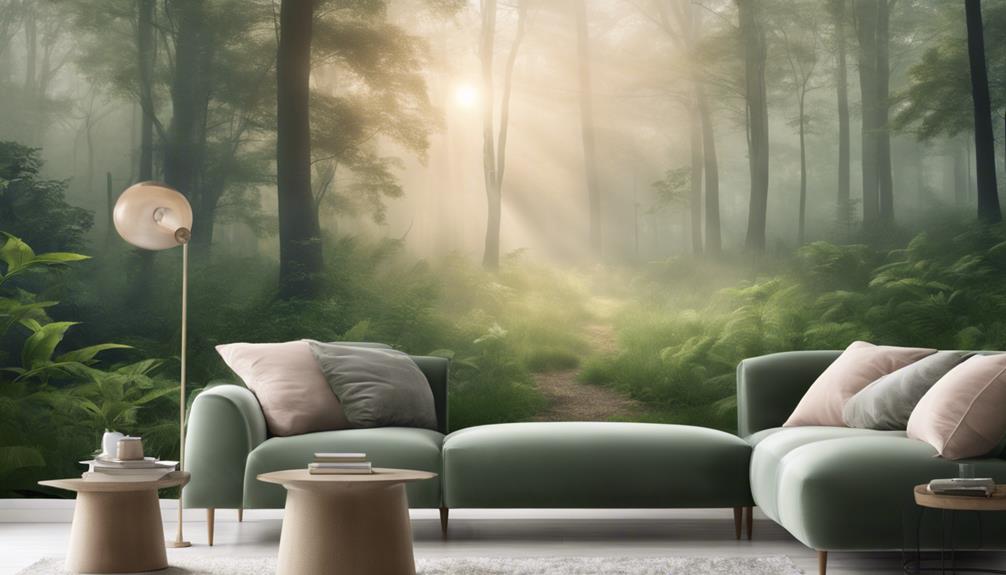
Leave a Reply